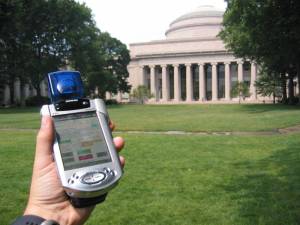Serious Game Classification
Environmental Detectives (ED) MIT Teacher Education Program / The Education Arcade (U.S.A.), MIT Media Lab (U.S.A.), 2003
Classification
SERIOUS GAME(Edugame)
Purpose
Besides play, this title features the following intents:- Educative message broadcasting
- Training
Market
This title is used by the following domains:- Education
- Scientific Research
Audience
This title targets the following audience:Age : 17-25 / 25-35
Students
Gameplay
The gameplay of this title is Game-based(designed with stated goals)
 Environmental Detectives was the first AR game created by the MIT TEP. It was targeted at high school and university students. In this game students play the role of environmental engineers who are presented with the following scenario at the beginning of the simulation:
Environmental Detectives was the first AR game created by the MIT TEP. It was targeted at high school and university students. In this game students play the role of environmental engineers who are presented with the following scenario at the beginning of the simulation:
Students watch a 60 second digital video-briefing from the University president where they are enlisted to investigate the spill of the toxin, a carcinogenic degreasing agent which is commonly found in machine shops, cafeterias, and hospitals. The goal of the game is to locate the source of the spill, identify the responsible party, design a remediation plan, and brief the president of the University on any health and legal risks so that he will be prepared for a meeting with the EPA – all within two hours. At the end of the game, students make a five minute presentation to their peers outlining their theory behind the spill. The spread of the toxin is simulated on a location-aware Pocket PC, which functions as a tool which students can use to investigate the toxic spill. Each Pocket PC is equipped with a GPS device, which allows players to sample chemical concentrations in the groundwater depending on their location. Players are given three reusable drilling apparatuses which they can use to drill for water samples. After drilling for a sample, players must wait three minutes for the sample to return, meaning that students can only take three samples at a time, and are forced to develop sampling strategies in order to optimize the amount of ground that they can cover in limited time. Because the GPS data is only accurate within 10 meters, there is some built-in error to the collected readings as well.
Environmental Detectives contains a multimedia database of resources which students can use to learn more about the chemical, where it is found on campus, the health risks associated with exposure to the toxin, how it flows through ground water, relevant EPA regulations, remediation strategies for cleaning up the toxin, and the political and economic consequences of EPA violations on campus. Students access these resources by obtaining interviews from virtual university faculty and staff who we have spread across campus at locations roughly corresponding with actual operations. Because time is limited and there is not enough time to interview everyone or to drill more than a handful of wells, students must make choices between collecting interviews, gathering background information, and drilling wells, adjusting and reprioritizing goals as new information becomes available.
Platform(s) : Mobile
 Français
Français English
English